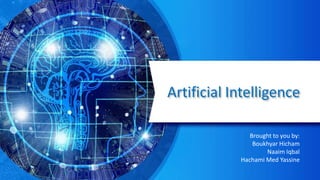
Artificial intelligence
- 1. Artificial Intelligence Brought to you by: Boukhyar Hicham Naaim Iqbal Hachami Med Yassine
- 2. PLAN • General Definition • History • Current status • Future • Challenges
- 3. What Is AI ??? • The study of computer systems that attempt tomodel and apply the intelligence of human mind. • A branch of computer science dealing with the simulation of intelligent behaviour in computers. • The capability of a machine to imitate intelligent human behaviour. • Borrowing characteristics from human intellligence and applying them as algorithms in a computer friendly way . • It works by combining large amonts of data with fast , iterative processing and intelligent algorithms allowing the software to learn automatically from patterns or features in the data.
- 4. How AI started ? • In the beginning, English mathematician Alan Turing wrote a landmark paper titled “Computing Machinery and Intelligence” that asked the questions: “Can machines think?” • A workshop at Dartmouth sponsored by John McCarthy. In the proposal for that workshop, he coined the phase a “Study of Artificial Intelligence”. • John McCarthy, who is the Father of Artificial Intelligence, was a pioneer in the fields of AI. He not only is credited to be the founder of AI, but also one who coined the term Artificial Intelligence. • In 1955, John McCarthy coined the term Artificial Intelligence, which he proposed in the famous Dartmouth conference in 1956. This conference attended by 10-computer scientists, saw McCarthy explore ways in which machines can learn and reason like humans.
- 5. Every feature of intelligence or learning aspects in principle can be so precisely described that a machine can seamlessly
- 6. Current status of AI • AI have taken many shapes and forms over recent years : Mobile Phones Video Games Characters GPS / Voice Recognition Robotics • Technologies are more enhanced than previous time. Any technological solution is available to the industries. • Voice assistants helps in many work such as in IT, automotive and retail industries. • Chatbots are part of Current Status of AI. Which have reduced the hassle of replying huge common messages manually. • AI technology has made to deploy any mobile devices and apps in one of the easiest ways across industries. • Cloud Service has been more easier in the current status of AI. • Emerging AI technologies include augmented intelligence such as some forms of face recognition, which seeks to enhance human intelligence and edge AI, where AI algorithms are processed locally without the need for an internet connection
- 7. Future of AI • Education: Textbooks are digitized with the help of AI, early-stage virtual tutors assist human instructors and facial analysis gauges the emotions of students to help determine who’s struggling or bored and better tailor the experience to their individual needs. • Media: Journalism is harnessing AI, too, and will continue to benefit from it. Bloomberg uses Cyborg technology to help make quick sense of complex financial reports. The Associated Press employs the natural language abilities of Automated Insights to produce 3,700 earning reports stories per year — nearly four times more than in the recent past. • Customer Service: Last but hardly least, Google is working on an AI assistant that can place human-like calls to make appointments at, say, your neighborhood hair salon. In addition to words, the system understands context and nuance.
- 8. Future of AI • Transportation: Although it could take some time to perfect them, autonomous cars will one day ferry us from place to place. • Manufacturing: AI powered robots work alongside humans to perform a limited range of tasks like assembly and stacking, and predictive analysis sensors keep equipment running smoothly. • Healthcare: In the comparatively AI-nascent field of healthcare, diseases are more quickly and accurately diagnosed, drug discovery is sped up and streamlined, virtual nursing assistants monitor patients and big data analysis helps to create a more
- 9. Future of AI • The Future state of AI is Self Aware AI. Where the machine will be aware before any incident happens. If any incident is seems to be occur AI will provide a signal from the previous experience, knowledge and saved data. • Self Aware AI is not established yet. So, this will be the future status of AI.
- 10. Challenges • As it is stated, AI use POWER-HUNGRY Algorithms. These Algorithms require a supercomputer’s computing system. IT IS NOT CHEAP. • The companies now face the problemof using local data for developing applications for the world, and that would result in bias. With biased information, the entire system could become flawed. • Most AI applications make use of a significant amount of data for learning and making intelligent decisions. The drawback of utilizing large volumes of data is that it may create a storage issue for businesses.
- 11. Programming languages Used for AI • C++ • PYTHON • JAVA • PROLOG • LIPS
- 12. Advantages • Precision and Accuracy. • Can do laborious tasks. • Function without stopping, Risk Reducing. • Fraud detection, managerecords. • There will be less injuries and stress to human beings. • It can help improve our way of life.
- 13. Disavdantages • Cost incurred in the maintenance and repair. • Lack of a creative mind • Robots superseding humans (replacing) • Unemployment. • Wrong hands causes destruction • Lack of common sense
- 14. AI in daily life • FACIAL RECOGNITION • 3D PHOTOGRAPHY • SMART ASSISTANCE • NAVIGATION APPS • SPAM FILTERS • MEDIA RECOMMENDATIONS
- 15. Conclusion • Finally, AI is at the centre of a new enterprise to build computational modelsbof intelligence. The main assumption is that intelligence (human orbotherwise) can be represented in terms of symbol structures and symbolic operations which can be programmed in a digital computer.